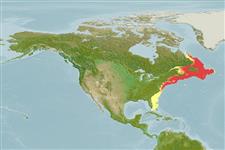Actinopterygii (ray-finned fishes) >
Gadiformes (Cods) >
Macrouridae (Grenadiers or rattails) > Macrourinae
Etymology: Nezumia: A Japanese word that means "mouse" .
Environment / Climate / Range
Ecology
Marine; benthopelagic; non-migratory; depth range 16 - 1000 m (Ref. 1371), usually 90 - 700 m (Ref. 1371). Subtropical, preferred ?; 59°N - 24°N, 81°W - 42°W (Ref. 1371)
Northwest Atlantic: Newfoundland, Canada to the northern end of the Straits of Florida, USA. A species reported from the northeastern Atlantic (Ref. 6321) should be reexamined. Report of specimen from the Azores and records from the Gulf of Mexico and West Indies (Ref. 6322) probably refer to other species.
Size / Weight / Age
Maturity: Lm ? range ? - ? cm
Max length : 40.0 cm TL male/unsexed; (Ref. 1371); max. reported age: 11 years (Ref. 40732)
Dorsal
spines
(total): 2;
Anal
spines: 0. Snout pointed; naked area on snout confined to median-ventral strip, otherwise head surfaces completely scaled. Spinules on scales slender, conical to lanceolate, arranged in convergent rows. Color when fresh gray with violet hue on trunk and lower jaw; silvery reflections on gill cover, parts of the suborbital, and trunk and tail below the lateral line; pelvic fins and membrane between spinous dorsal ray and first segmented ray black; pectoral and median fins otherwise dusky; oral and branchial cavities mostly black.
Benthic, reported as deep as 2295m (Ref. 58426). Taken much shallower in areas with cold surface waters. Feeds primarily on euphausiids, amphipods, and polychaetes, although a 200 mm individual had many copepods in its stomach (Ref. 1371).
Life cycle and mating behavior
Maturity | Reproduction | Spawning | Eggs | Fecundity | Larvae
Cohen, D.M., T. Inada, T. Iwamoto and N. Scialabba, 1990. FAO species catalogue. Vol. 10. Gadiform fishes of the world (Order Gadiformes). An annotated and illustrated catalogue of cods, hakes, grenadiers and other gadiform fishes known to date. FAO Fish. Synop. 125(10). Rome: FAO. 442 p. (Ref. 1371)
IUCN Red List Status (Ref. 115185)
CITES (Ref. 94142)
Not Evaluated
Threat to humans
Harmless
Human uses
Fisheries: minor commercial
Tools
Special reports
Download XML
Internet sources
